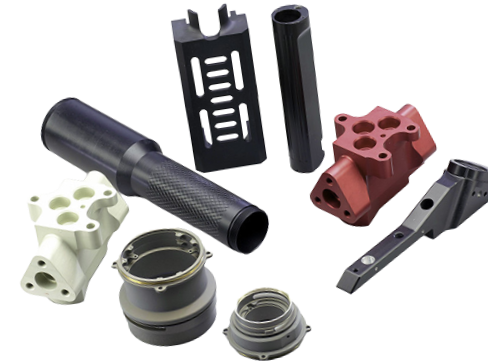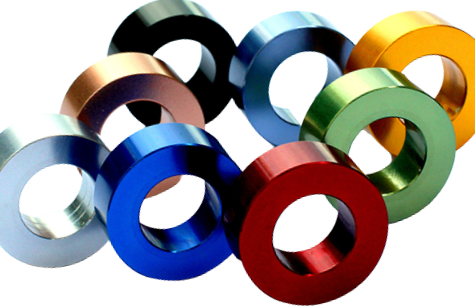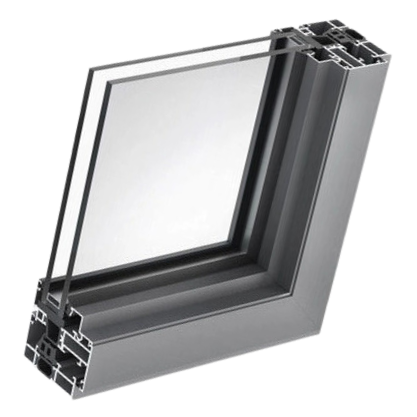Anodizing Treatment
Anodizing is a process of forming a protective oxide layer on the surface of metal substrates, primarily aluminum, through an electrolytic process. It is a popular surface treatment technique in industries such as aerospace, automotive, construction, and consumer goods.
The anodizing process involves immersing the metal substrate in an electrolyte solution, typically sulphuric acid, and applying a direct current to it. The current causes oxygen ions from the electrolyte to combine with the metal ions on the surface of the substrate, forming a layer of metal oxide.
Types of Anodizing
There are two main types of anodizing: sulphuric acid anodizing and hard coat anodizing.
- Sulphuric Acid Anodizing: This is the most common type of anodizing, which creates a thin, transparent layer of aluminum oxide on the surface of the substrate. The thickness of the oxide layer can be controlled by adjusting the time and current used during the process. Sulfuric acid anodizing can produce a range of colors, including black, gold, and bronze, through a process called dyeing.
- Hard Coat Anodizing: Hard coat anodizing is a specialized type of anodizing that produces a much thicker and harder layer of aluminum oxide than sulfuric acid anodizing. This type of anodizing is typically used for applications where the substrate will be exposed to harsh environments or require increased wear resistance. Hard coat anodizing also provides a range of colors, including natural, black, and bronze.
Variables and parameters that can affect the anodizing process
- Type and Concentration of Electrolyte: The type and concentration of the electrolyte solution used in the anodizing process can affect the thickness and quality of the oxide layer. Sulfuric acid concentration and temperature are two important parameters that can impact the anodizing process.
- Current Density: Current density refers to the amount of current flowing through the substrate during the anodizing process. It is an essential variable that can determine the thickness and quality of the oxide layer. Controlling the current density is crucial to achieve the desired results.
- Time: The time duration of the anodizing process can impact the thickness and quality of the oxide layer. Longer anodizing times can lead to thicker layers, while shorter times can result in thinner layers.
- Surface Preparation: The quality of the substrate surface is an essential parameter that can impact the anodizing process. Proper surface preparation, including cleaning, degreasing, and etching, can help to ensure a high-quality oxide layer.
- Temperature: Temperature is another important parameter that can affect the anodizing process. Higher temperatures can lead to faster anodizing times, but excessive temperatures can lead to uneven oxide layer formation and poor adhesion.
- Type of Aluminum Alloy: Different aluminum alloys can have varying responses to the anodizing process. For example, some alloys may produce a more uniform oxide layer than others.
By carefully controlling these variables and parameters, it is possible to achieve the desired results in anodizing, such as a specific oxide layer thickness or color.
Benefits of Anodizing
Anodizing offers several benefits, including:
- Corrosion Resistance: Anodized aluminum has a superior level of corrosion resistance compared to untreated aluminum. The oxide layer formed during anodizing creates a barrier that protects the metal substrate from environmental elements.
- Improved Surface Properties: Anodizing can improve the surface properties of the substrate, including its hardness, wear resistance, and electrical insulation.
- Aesthetics: Anodizing can produce a range of colors and finishes, providing an aesthetic appeal for decorative or branding purposes.
- Environmentally Friendly: Anodizing is an environmentally friendly process as it does not produce hazardous waste, and the by-products can be easily disposed of.
Disadvantages of Anodizing
Despite the benefits, there are some limitations and disadvantages to anodizing, including:
- Limited Colors: Anodizing offers a limited range of colors compared to other surface treatment techniques such as painting or powder coating.
- Surface Preparation: The quality of the anodized layer is dependent on the surface preparation of the substrate. Any surface imperfections or contaminants can impact the quality of the layer.
- Cost: Anodizing can be an expensive process, especially for hard coat anodizing, due to the specialized equipment and expertise required.
Conclusion
In conclusion, anodizing is a versatile surface treatment technique that offers several benefits, including corrosion resistance, improved surface properties, and aesthetics. With its environmentally friendly process, it is a preferred method of surface treatment for many industries. However, it is essential to weigh the advantages and disadvantages of anodizing to determine its suitability for specific applications. Overall, anodizing is a valuable process for enhancing the properties of metal substrates and plays a significant role in various industries.



